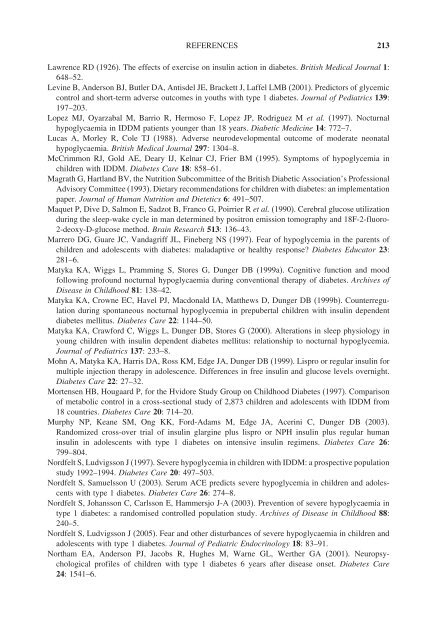Hypoglycaemia in Clinical Diabetes
Hypoglycaemia in Clinical Diabetes
Hypoglycaemia in Clinical Diabetes
- No tags were found...
Create successful ePaper yourself
Turn your PDF publications into a flip-book with our unique Google optimized e-Paper software.
REFERENCES 213Lawrence RD (1926). The effects of exercise on <strong>in</strong>sul<strong>in</strong> action <strong>in</strong> diabetes. British Medical Journal 1:648–52.Lev<strong>in</strong>e B, Anderson BJ, Butler DA, Antisdel JE, Brackett J, Laffel LMB (2001). Predictors of glycemiccontrol and short-term adverse outcomes <strong>in</strong> youths with type 1 diabetes. Journal of Pediatrics 139:197–203.Lopez MJ, Oyarzabal M, Barrio R, Hermoso F, Lopez JP, Rodriguez M et al. (1997). Nocturnalhypoglycaemia <strong>in</strong> IDDM patients younger than 18 years. Diabetic Medic<strong>in</strong>e 14: 772–7.Lucas A, Morley R, Cole TJ (1988). Adverse neurodevelopmental outcome of moderate neonatalhypoglycaemia. British Medical Journal 297: 1304–8.McCrimmon RJ, Gold AE, Deary IJ, Kelnar CJ, Frier BM (1995). Symptoms of hypoglycemia <strong>in</strong>children with IDDM. <strong>Diabetes</strong> Care 18: 858–61.Magrath G, Hartland BV, the Nutrition Subcommittee of the British Diabetic Association’s ProfessionalAdvisory Committee (1993). Dietary recommendations for children with diabetes: an implementationpaper. Journal of Human Nutrition and Dietetics 6: 491–507.Maquet P, Dive D, Salmon E, Sadzot B, Franco G, Poirrier R et al. (1990). Cerebral glucose utilizationdur<strong>in</strong>g the sleep-wake cycle <strong>in</strong> man determ<strong>in</strong>ed by positron emission tomography and 18F-2-fluoro-2-deoxy-D-glucose method. Bra<strong>in</strong> Research 513: 136–43.Marrero DG, Guare JC, Vandagriff JL, F<strong>in</strong>eberg NS (1997). Fear of hypoglycemia <strong>in</strong> the parents ofchildren and adolescents with diabetes: maladaptive or healthy response? <strong>Diabetes</strong> Educator 23:281–6.Matyka KA, Wiggs L, Pramm<strong>in</strong>g S, Stores G, Dunger DB (1999a). Cognitive function and moodfollow<strong>in</strong>g profound nocturnal hypoglycaemia dur<strong>in</strong>g conventional therapy of diabetes. Archives ofDisease <strong>in</strong> Childhood 81: 138–42.Matyka KA, Crowne EC, Havel PJ, Macdonald IA, Matthews D, Dunger DB (1999b). Counterregulationdur<strong>in</strong>g spontaneous nocturnal hypoglycemia <strong>in</strong> prepubertal children with <strong>in</strong>sul<strong>in</strong> dependentdiabetes mellitus. <strong>Diabetes</strong> Care 22: 1144–50.Matyka KA, Crawford C, Wiggs L, Dunger DB, Stores G (2000). Alterations <strong>in</strong> sleep physiology <strong>in</strong>young children with <strong>in</strong>sul<strong>in</strong> dependent diabetes mellitus: relationship to nocturnal hypoglycemia.Journal of Pediatrics 137: 233–8.Mohn A, Matyka KA, Harris DA, Ross KM, Edge JA, Dunger DB (1999). Lispro or regular <strong>in</strong>sul<strong>in</strong> formultiple <strong>in</strong>jection therapy <strong>in</strong> adolescence. Differences <strong>in</strong> free <strong>in</strong>sul<strong>in</strong> and glucose levels overnight.<strong>Diabetes</strong> Care 22: 27–32.Mortensen HB, Hougaard P, for the Hvidore Study Group on Childhood <strong>Diabetes</strong> (1997). Comparisonof metabolic control <strong>in</strong> a cross-sectional study of 2,873 children and adolescents with IDDM from18 countries. <strong>Diabetes</strong> Care 20: 714–20.Murphy NP, Keane SM, Ong KK, Ford-Adams M, Edge JA, Acer<strong>in</strong>i C, Dunger DB (2003).Randomized cross-over trial of <strong>in</strong>sul<strong>in</strong> glarg<strong>in</strong>e plus lispro or NPH <strong>in</strong>sul<strong>in</strong> plus regular human<strong>in</strong>sul<strong>in</strong> <strong>in</strong> adolescents with type 1 diabetes on <strong>in</strong>tensive <strong>in</strong>sul<strong>in</strong> regimens. <strong>Diabetes</strong> Care 26:799–804.Nordfelt S, Ludvigsson J (1997). Severe hypoglycemia <strong>in</strong> children with IDDM: a prospective populationstudy 1992–1994. <strong>Diabetes</strong> Care 20: 497–503.Nordfelt S, Samuelsson U (2003). Serum ACE predicts severe hypoglycemia <strong>in</strong> children and adolescentswith type 1 diabetes. <strong>Diabetes</strong> Care 26: 274–8.Nordfelt S, Johansson C, Carlsson E, Hammersjo J-A (2003). Prevention of severe hypoglycaemia <strong>in</strong>type 1 diabetes: a randomised controlled population study. Archives of Disease <strong>in</strong> Childhood 88:240–5.Nordfelt S, Ludvigsson J (2005). Fear and other disturbances of severe hypoglycaemia <strong>in</strong> children andadolescents with type 1 diabetes. Journal of Pediatric Endocr<strong>in</strong>ology 18: 83–91.Northam EA, Anderson PJ, Jacobs R, Hughes M, Warne GL, Werther GA (2001). Neuropsychologicalprofiles of children with type 1 diabetes 6 years after disease onset. <strong>Diabetes</strong> Care24: 1541–6.
















